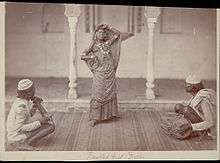Nautch



In North India, Nautch (/ˈnɔːtʃ/) is one of several styles of popular dance, performed by girls known as Nautch girls. The word Nautch is an anglicized version of नाच (nāc), a word found in Hindi and Urdu (where it is spelled ناچ), and several other languages of North India, derived from the Sanskrit, Nritya, via the Prakrit, Nachcha. A simple and literal translation of Nautch is "dance" or "dancing".
The culture of the performing art of Nautch rose to prominence during the later period of Mughal Empire, and the British East India Company Rule.[1] Over time, the Nautch traveled outside the confines of the Imperial courts of the Mughals, the palaces of the Nawabs and the Princely states, and the higher echelons of the officials of the British Raj, to the places of smaller Zamindars, and other places.
Some references use the terms Nautch and Nautch girls to describe Devadasis who used to perform ritual and religious dances in the Hindu temples of India. However, there is not much similarity between the Devadasis and the Nautch girls. The former performed dances, mostly Indian classical dances, including the ritual dances, in the precincts of the Hindu temples to please the temple deities, whereas the Nautch girls performed Nautches for the pleasure of men. In 1917, attributing the adjective to a woman in India would suggest her entrancing skill, tempting style and alluring costume could mesmerize men to absolute obedience.[2]
See also
- Dance bar
- Devadasi
- Helen
- Indian folk dances
- Tawaif
- The Nautch Girl (1891 opera)
Further reading
References
- ↑ "Nautch girls: Sahibs danced to their tune". Retrieved 25 July 2004.
- ↑ Yasmini in "King, of the Khyber Rifles" by Talbot Mundy ISBN 0854681779 Tom Stacey 1972 orig 1917 hb, p16
External links
![]() Media related to Nautch at Wikimedia Commons
Media related to Nautch at Wikimedia Commons